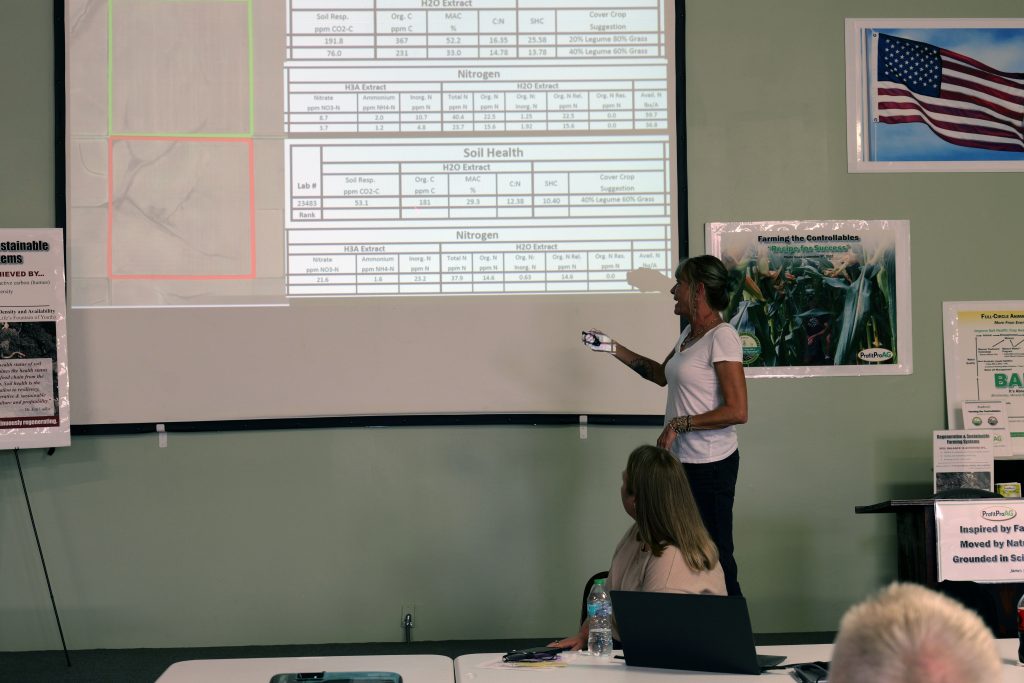Use the Haney Test to Unlock Free Fertilizer in Your Field Part 1
Concerned about high fertilizer prices? It’s time to start asking these two key questions to maximize your fertilizer investment:
- Are my management practices effective in releasing the free fertilizer that’s already in my fields?
- Are my soil microbes happy?
The Haney test offers an effective way to help answer these questions. It has been called the only soil test that’s designed to directly reduce fertilizer applications. That’s why we invited Liz Haney to lead a half-day workshop at our headquarters in Minnesota to help farmers learn how to interpret the data from the Haney test.  “Healthier soils require fewer fertility inputs,” said Jim Ladlie, founder and CEO of ProfitProAG. “We’re a big proponent of the Haney test and the soil health information it can provide.”
“Healthier soils require fewer fertility inputs,” said Jim Ladlie, founder and CEO of ProfitProAG. “We’re a big proponent of the Haney test and the soil health information it can provide.”
An essential tool in a regenerative farm management system, the Haney soil health test measures soil biological health by looking at nutrient availability and microbial activity. It reflects the complex ecosystem of the soil, rather than relying solely on the narrow measurements of N, P, and K.
This approach differs from conventional tests, which often cause excess fertilizer use because typical extractants don’t measure plant-available nutrients.
“Plant available” is the key, said Haney, who noted that improving soil health and the biological function of the soil increases the crop’s nutrient-use efficiency. Beneficial microbes in a healthy soil ecosystem help unlock nutrients that are already in the soil and make them available for plant uptake.
The Haney Test measures major nutrients such as phosphorus and potassium, plus it evaluates various soil health indicators, such as soil respiration, to analyze soil biological activity. “The Haney test measures how active the microbes in your soil are,” Liz Haney said.
The Haney Test also focuses on how much carbon (C) and nitrogen (N) are in the soil. A soil health score is calculated from a combination of these different soil health indicators. Depending on the results of a Haney Test, a farmer can potentially lower N application rates, since this test measures both organic N and inorganic N. “Nitrogen is the biggest way you can save money using the Haney test,” Liz Haney said.
Measuring soil microbes at work
Soil health depends on a diverse array of microbes. There are a variety of ways to measure soil microbes, including PLFA (phospholipid fatty acid) analysis, which is another test that’s offered by Regen Ag Lab. The PLFA test can provide a real-time snapshot of the soil microbial community. “You can see how many bacteria, fungi, and protozoa there are, and in what balance,” Haney said.
The PLFA pays special attention to:
- Arbuscular mycorrhizal fungi (AMF), are critical for phosphorus uptake.
- Saprophytic fungi, which help break down residue in the field.
- Protozoa. These tiny predators release nutrients like nitrogen as they graze on bacteria.
The Haney test relies on modern technology to help measure these important soil health factors. “Twenty years ago, we didn’t know how to measure organic N or measure fungi in the soil,” Haney said. “Now we do.”
The Haney test uses an integrated approach of chemical and biological soil test data to mimic nature’s approach to soil nutrient availability, as best as can be done in a lab. The test helps farmers answer three important questions:
- What’s the current condition of my soil?
- Is my soil in balance?
- What can I do to improve my soil?
While the Haney test can offer important insights, it’s important to note that it will not completely answer them. By giving a better understanding of microbial activity and the nutrients naturally available in the soil, the Haney test can help you improve your crops and reduce your input costs.
“The Haney test is a guideline,” said Haney, who noted that context is key to interpreting the soil test results. “As you use the Haney test, consider the context of your farm to determine fertilizer recommendations for your acres.”
Let’s talk
Want to know more about how to put the Haney test and PLFA to work on your acres? ProfitProAG can help. Contact us for more details, and watch for part 2 of this series coming soon!
Office – 507-373-2550 / info@profitproag.com
Dr. Jim Ladlie – 507-383-1325 / jladlie@profitproag.com
Dennis Klockenga – 320-333-1608 / dklockenga@profitproag.com
Chris Chodur – 507-402-4195 / cchodur@profitproag.com
